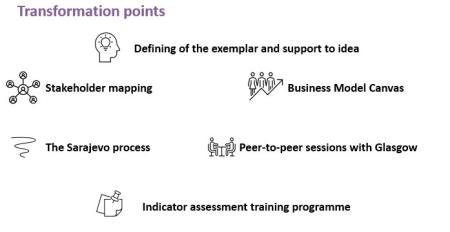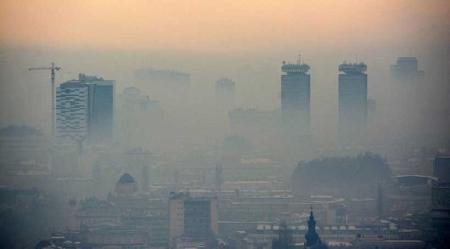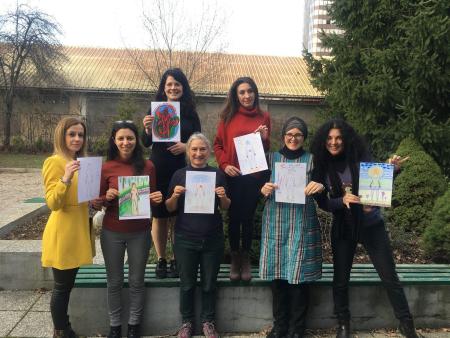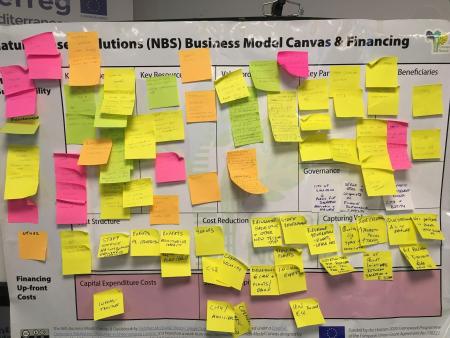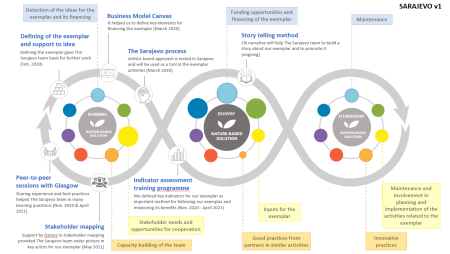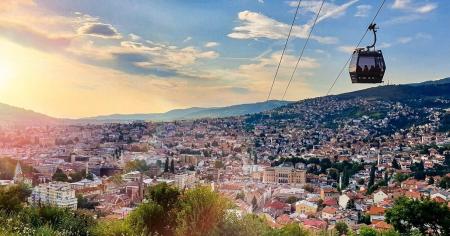
Area characterisation:
Sarajevo is capital and largest city in Bosnia and Herzegovina, a city located in the valley, surrounded by mountains, situated along the Miljacka River in the heart of the Balkans, a region of Southern Europe. Sarajevo has a rich and long history of religious and cultural diversity, which experienced its development in the 80s of the last century (e.g. Winter Olympic Games in 1984).
During the nineties of the 20th century Sarajevo experienced the destruction and for 1,425 days (from April 1992 to February 1996), the city suffered the longest siege of a capital city in the history of modern warfare, after that the recovery is still slow.
Due to the destruction, Sarajevo has encountered a number of problems in several segments, there is an evident problem of pollution, especially in the winter, deforestation, turning green areas into parking lots and buildings, and illegal construction that affects airflow, which exacerbates pollution. Sarajevo faces the problem of traffic and heating that affect pollution as well, and this problem requires systemic changes, not short-term solutions.
Now, Sarajevo is characterised with a lot of new buildings for living and business purposes, but often, these buildings are built on green areas within the municipalities and local communities, often not respecting urban planning. This approach creates additional issues, such as lack of wind, creating high pollution and fog in winter periods.
Sarajevo, as a modern city, is a complex of buildings for various purposes: architectural and infrastructural buildings, free spaces, water surfaces, green plantations, etc. However, the city cannot be defined as a mechanical sum of its constituent elements, but a connected whole, which is constantly growing and evolving. The character of the interconnections of the components of that system is complex and determined by numerous factors. However, the basic condition for its normal functioning is ecological unity. A certain balance of environmental factors, which form the area of the city, primarily determines the living conditions of the inhabitants.
It is important to mention Sarajevo administrative organisation, which directly determines jurisdiction of the government of the city level. Area of the City of Sarajevo covers four municipalities: Stari Grad, Centar, Novo Sarajevo and Novi Grad. City Council consists of representatives of these municipalities.
There are some excellent examples of the creation of the green areas in the city. In some municipalities such as Novi Grad former military objects are transformed into multifunctional park “Safet Zajko”. The Park is intended for education, sports and recreation, with beautiful green areas. These initiatives have positive feedback from citizens.
Canton Sarajevo consists of 9 municipalities
View on Sarajevo and cable car
Many projects and initiatives from the private and public sector have been implemented in recent years, but they are mostly pilot activities that are not replicated yet. Usually, these are small scale projects, but even though they are “small”, they are very important for a city and citizens. Some of these projects are solar panels, solar benches, bike paths, etc. The City of Sarajevo as a local self-government unit supports all types of projects and initiatives especially capitals such as the Sarajevo Cable Car. As a city, Sarajevo unfortunately does not have enough green areas. Large green spaces are located on the hills around the city (Trebević Hum, Barice etc.). Small parks,
promenades and green corridors along the roads are only green areas in the city. These surfaces are maintained by KJKP PARK (Cantonal Public Utility Company PARK).
One of the ways to improve the environment is to raise green areas. In order for green areas to be able to fulfil health, microclimatic and aesthetic functions, it is of great importance to connect them into a single system of greenery, which must be set on certain organizational principles.
There is evident increasing concentration of population in small areas. This causes the appearance of various sources of atmospheric pollution (soot, gases, dust, etc.) Plants are among the rare living organisms that can resist the effects of air pollution. Therefore, the positive role of plants is reflected not only in the decorative-aesthetic role,
but also in a number of other functions, of which most importantly sanitary-hygienic and cultural-educational.
Need for nature-based projects and their long-term significance for the city and its inhabitants is still not sufficiently developed within all layers of government- from municipal and city level, cantonal, entity and finally state level, there is no strategic goal for the environment, particularly NbS is not recognised as a priority. Bearing in mind that the development of the city is a constant process, there are great opportunities for such solutions, which should be an integral part of the plans of all levels of the state.
Objective:
The development of a resilient city pleasant for the life of citizens of all ages and the satisfaction of their needs is one of the goals of the City, but also of other institutions. The City of Sarajevo faces challenges in achieving these goals (often insufficient financial resources, shared competencies, political factors, etc.). These challenges faced the Agency, as well, and they were taken into account in defining the exemplar.
The visit of Osmos in November 2018 identified the main challenges and problems in the city, but also identified and interviewed various stakeholders, which provided the basis for further work.
Several exemplary options were considered internally and discussed (energy efficiency, environmental protection, etc.).
Within the workshop with Nua Horizon (held in February 2020), the Agency and the City defined an exemplar that included several factors: economic, social, environmental, etc., and due to events in the recent history of BiH and the city, another additional factor was taken into consideration, and that is peace and reconciliation. Thus, the first idea of the example was a park of friendship/ future on the border between the two cities, but after considering the administrative requirements and due to the complicated bureaucracy, the second idea was approached.
Bearing in mind that there is a lack of green areas, the exemplar envisages the design and implementation of an urban garden with sensory park, which will have multifunctional purposes. Also, the goal is for the exemplar to have a cross-generational exchange (youth, elderly people), to be inclusive (for sensitive groups e.g. children with disabilities) and to have an educational character as an added value.
The urban garden with sensory park will be implemented on a green area, and it is in accordance with the urban plan of the city, but also with a strategy of the development of the Sarajevo Canton. Also, as an important step, SERDA proposed NbS as one of the priorities in development strategy of the Municipality of Novo Sarajevo (in its territory the urban garden will be placed) and it is accepted, and later strategy is adopted by Municipal Council.
Implementation of the first urban garden with sensory elements will be done by established cooperation of two governmental levels, with involvement of NGO and international support and can be used as a model for larger projects in Sarajevo and other cities in BiH.
Images
Financing:
Business Model Canvas workshop was held in Sarajevo, in February 2020 by Horizon Nua, which helped us to identify main financing opportunities and models for or exemplar. It helped the Sarajevo team to think wider and to apply comprehensive approach to this important section of the exemplar.
During our work on Business Model Canvas, special attention was on financing the exemplar, as the Team determined it as one of the possible obstacle (based on experience and current situation on COVID).
Therefore, during and after work on BMC, following financing opportunities were identified: involvement of government in order to provide systematic support (financing, technical preconditions, permits etc),
- by involving SMEs active in environmental protection in order to support them, but also to provide quality implementation and maintenance of the urban garden,
- to invite NGO sector to integrate their experience in designing the urban garden, and most important
- financing through available domestic and international funds.
Potential impacts/benefits:
The exemplar in Sarajevo will be focused to include following segments: societal, economic and environmental, but also to connect different age groups.
The idea is to create an urban garden and sensory park which will have multifunctional purposes and will be open to all citizens, but it would be adjusted to special target groups.
The exemplar includes design and implementation of green garden and sensory park within the Secondary Vocational Education and Training School. Location of the School is in the Municipality of Novo Sarajevo, urban area, surrounded by the pedestrian lane by the river on the one side and busy street with residential are on the other side. Nearby the School there are other relevant institutions/organization: elementary school with children with disabilities, centre for healthy ageing, municipality, shops, kindergarten, elementary school etc. This surrounding is important for the purpose of the exemplar and main activities (urban gardening day, cross generational exchange etc).
Beside the establishment of the garden, exemplar will include use of the artistic tool developed within the project (e.g. Memory work, Eco Therapy, Immersion in Nature and Body Mapping). This tool will be implemented in order to connect people with the nature and inspire them to spend more time in nature and participate in activities envisaged in the urban garden. Also, the tool is recognised as appropriate to gather different generational groups (youth and elderly people) to share their experiences. In this way, it will foster intergenerational exchange, but also it will provide socialisation of the specific target groups who are often disconnected from the society (elderly).
The main aim of exemplar is to create a multifunctional green area within the urban part of the city, which will be a pilot project and replicable in other areas. Decision on the exemplar which includes implementation of a green garden is based on real needs of the city (lack of green areas), but also as a tool for solving issues detected by government such as air pollution due to heating system, traffic, deforestation etc.
Size of the area for the exemplar is approx. 1500m2, surrounded by a busy street and pedestrian lane/promenade, next to the river.
Beside the establishment of the garden, exemplar will include one additional important element - artistic approach to connect with nature (The Sarajevo Process) which is developed within the Connecting Nature project.
The green garden and sensory park will have double purpose: 1) it would provide multipurpose area for the pupils of the School (urban garden will be used for learning and sensory park will be used for developing motoric skills of the pupils) 2) it would include various activities (e.g. urban gardening day) for various target groups in order to provide societal, economic and environmental segments, but also to contribute in solving issues of Sarajevo (air pollution, raising awareness on importance of nature in everyday life etc). Taking into account that urban garden and sensory park will be located in urban area of the city, and it is surrounded with streets open for traffic (creating pollutions and noise) with evident lack of the green areas, the exemplar will be oasis for local habitants and members of the school and other above-mentioned institutions/organisations.
In setting up the garden and the park, the partners will be municipality, school, centre for healthy ageing, company Greens (socially responsible company which employs persons with disabilities and produces microgreens). We will involve KJKP Park, public company in charge of greenery, for donation of seeds and plants. These are the main actors in implementation of the garden. For sustainability, beside these actors, it is important to involve other actors: Centre for Healthy ageing and elementary school for children with disabilities for creation of activity plan and various events and activities within the garden (e.g., ''the urban garden day''). Important part of the activities will be co-production, ensured through The Sarajevo Process (the memory work, body mapping, eco therapy) which will have multiple values - creating connections between participant and benefits for health and wellbeing (stress release, calmness etc). It is planned develop ''urban garden membership'' and have symbolic badges or stickers, and data base of people who are participating at maintaining the garden. All these activities will be followed by a journalist who is active in writing articles about urban agriculture. And all activities will be filmed. We will suggest promoting this urban garden through social media (FB/Instagram) Urban Garden Sarajevo.
Actions:
Taking into account the specifics of the city, as well as the needs and challenges it’s faces, and the problem it currently has, exemplar is one of the steps, but also a way to contribute to solve the city problems and to improve the quality of life.
Thus, the Sarajevo Team started from the exemplar goal, activities that are needed to achieve the goal, and through the definition of activities, the Sarajevo Team came to a set of needs that will enrich the exemplar and implement it in a way that has multiple purposes.
Connecting Nature framework allowed the Sarajevo Team to fantasize, and to go a step further and think long term and to see the exemplar as one of the steps in its development and upgrading.
It covered main phases:
Planning phase: included detection of ideas for the exemplar and its financing – defining the exemplar provided the Sarajevo team basis for further work, including peer-to peer sessions with FRC Glasgow – sharing experience and best practices helped the Sarajevo Team in many learning questions and stakeholder mapping – gave the Team wider picture in key actors for the exemplar; Business Model canvas helped the team to define key elements for the financing the exemplar and The Sarajevo process – artistic based approach firstly tested in Sarajevo, which will be used as a tool in the exemplar activities.
Delivery phase: included activities regarding funding opportunities and financing the exemplar, ex-change of good practices in similar activities (Glasgow, Poznan, A Coruna) and inputs for the exemplar – stakeholder needs and opportunities for cooperation; indicator assessment training programme – defining key indicators for the exemplar as important method for measuring the benefits.
Stewardship phase will involve maintenance of the exemplar and its replication in other areas of the city, but also ambition to create sustainable model for the design and implementation of the urban gardens and its recognition as strategic project of the city/canton.
Organisations:
Based on gained knowledge and advices from Osmos, but also other partners (e.g. City of Glasgow) The Sarajevo Team identified Key partners in the first phase: SERDA, City of Sarajevo, Municipality Novo Sarajevo, Secondary Vocational Education and Training School and Centre for healthy aging as main operational and implementing partners. The exemplar can be implemented within these institutions. Also, as the exemplar includes urban garden, it is necessary to include public or private enterprise for providing materials for the exemplar. Project partners will include KJKP Park (which maintain green areas within the City and Canton) and/or some private SME which will provide materials and to promote its products/services and provide it for the exemplar and other local companies who can contribute to the exemplar (e.g. www.farmer.ba, online shop of domestic products, where the exemplar can be promoted and their users can be invited to join). Currently, The Sarajevo Team works on operationalisation of cooperation with key actors.
As supporting partners can be involved: UNDP, University of Sarajevo (relevant faculties), and NGOs dealing with environmental protection, youth etc.
Later the exemplar would be presented to the relevant ministries (for environment, education, economy) in order to replicate and implement urban gardens in future. City “ideal” governance model for long-term management of the exemplar will be combination of the city and citizen managed urban garden. Local governance would provide budget for managing and maintaining the urban garden (higher investments and works) and citizens would manage its parts during urban garden activities (cleaning, seeding, watering etc).
In later phases, relevant ministries on other state levels will be included, as well as various potential donors. Taking into account planned promotion, embassies and other international organisations will be target groups for project involvement.
Global goals:
-
3. Good Health and well being
-
4. Quality education
-
5. Gender Equality
-
10. Reduced inequalities
-
11. Sustainable cities and communities
-
15. Life on land
-
17. Partnerships for the goals
NBS goals:
- Enhancing sustainable urbanization
- Urban regeneration through nature-based solutions
- Nature-based solutions for improving well-being in urban areas
NBS benefits:
- Restoring ecosystems and their functions
- Increase Biodiversity
- Enhancing sustainable urbanisation
- Improve air quality
- Increase accessibility to green open spaces
- Increase communities’ sense of ownership
- Increase social interaction
- Increase well-being
- Social inclusion
- Social learning about location & importance of NBS
